

This page last modified: 27 September, 2013 (BRDM-2, BRDM-2PU, and 1V12 pictures added)

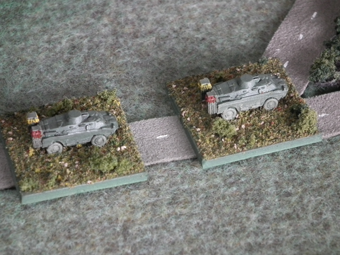
Shown above are the recon assets from a Czechoslovakian regimental NBC company. These are H&R Soviet BRDM-2Rkh vehicles. Externally, these differ from the standard BRDM-2 most notably in having 2 flag dispensers at the rear, and in having twin 7.62 mm MGs in the turret rather than a 14.5 mm plus 7.62 mm set. In real life, the Czechoslovakian BRDM-2rch differed again in having just a single machine gun, allowing a better set of NBC gear to be fitted. The rest of the company, with decontamination vehices, etc., doesn't need to be modelled in MSH, but extra recon elements can always find a place in any order of battle. Both red and yellow lane-marking flags were used, but exactly what the colours meant I haven't been able to find out yet. Here I've just assumed "stay left" or "stay right"; it's bound to be wrong!
Each Czechoslovakian Motor Rifle Divsion had an entire NBC battalion, as
it was assumed nuclear weapons would be used in any potential conflict
with NATO. Indeed, until the late 1970s, their non-use wasn't even
considered, let alone planned for. Very scary, really..., which is why
my Cold-War gamng is every bit as fantasy as playing Middle-Earth games.
Interestingly, the use of chemical weapons was NOT part of any of their
war plans, which is exactly the opposite of what most wargamers tend to
think (or used to, before this information was declassified by the Czech
government).
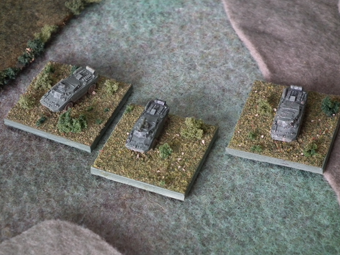

Above left is regimental recon company. This company is from a pre-1979 reorganization regiment from the 3rd Division, since it is entirely OT-65-based; from 1979, two of the platoons of the three would be equipped with BVP-1 instead. Alternatively, this particular company can be used as a reservist (MSH category III) division into the 1980s, since these often used equipment kept in storage that had often been retired from active formations, and which was manned by conscripts called up only in times of war. Note that some mobilization-only formations did use modern equipment; in particular, the army-level rocket brigades were the first to receive the excellent vz.70 MRL when it was introduced, despite their being war-time only formations.
The two vehicles on the left have been converted into OT-65As by adding
a tiny turret mounting a T-21 82 mm recoiless weapon; the Czechoslovakians used
this instead of the equivalent Soviet B-10 recoiless rifle. It's essentially a bazooka, and not to be confused with the vastly larger (but still 82 mm) BzK vz.59. Which unfortunately is exactly what the official MSH data sheet has done... The photo on the right shows such an OT-65A in close-up. The T-21 is supposed to be a nice straight piece of wire, but at the scale we are talking about here (5 mm long), "straight" is clearly a relative term :-)
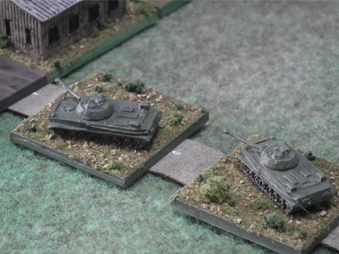
Above: PT-76 elements prepare to scout out a town. As with many other "standard" WarPac weapons systems, the Czechoslovakians went their own way with the PT-76, and decided not to adopt what would become the standard middle-weight recon vehicle throughout the rest of the Warsaw Pact. These models then, are used when I want to field a Polish force instead of a Czechoslovakian one.
What makes the situation with the PT-76 unusual is that the Czechoslovakians had
no domestic equivalent. A typical Soviet divisional reconnaissance company of
the 1960s might have a motorcycle platoon, an APC platoon in BRDM-1s, and a tank
platoon with three PT-76s; a divisional reconnaissance battalion would expand
these to full companies, except the tank company would mix 7 PT-76s with 3 MBTs, such as T-55s. A Czechoslovakian divisional recon battalion of the same era would have an APC company in e.g. OT-65s, either a motorcycle company if early 60s, or if the late 60s, another, smaller, APC company for deep reconnaissance, and a tank company with T-34/85s. It was not until the introduction of the BVP-1 that something more heavily armed than an APC was introduced that could also swim, by which time it was replacing plain OT-65s, as the T-34/85s had already been withdrawn. In Polish service, the PT-76 would soldier on into the 90s, with its last bastion as a fighting vehicle being with the Marines.
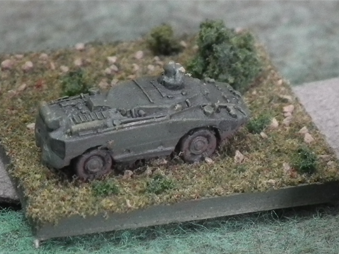
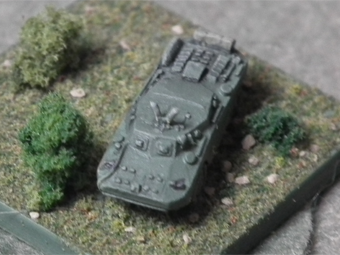
On the left is an OT-65, with a guy holding binoculars peering out the top hatch taken from the one of the ubiquitous Soviet artillery crew packs (both the standing and kneeling packs include a guy with binoculars). I use this as an artillery forward observer element rather than as a standard recce vehicle, which I leave unadorned with visible crew. The other way to signify an artillery observer's vehicle is to add a v-shaped stereoscopic periscope on top, which what you can see in the picture on the right. These are H&R OT-65 models; it's one of their best ones IMO, with nice crisp detail. I suspect not too many people buy OT-65s: even I've got only two two dozen, and I have more need of them than most. In addition to OT-65 observer's vehicles like these, I also have a couple of Soviet 1V12s for when I want to model a 1980s 1st echelon division with self-propelled 2S1s; however, many of my artillery observer vehicles are OT-810s. The artillery oberver variant of the OT-65 was ctaully called the OT-65DPP, or DPP OT-65M.
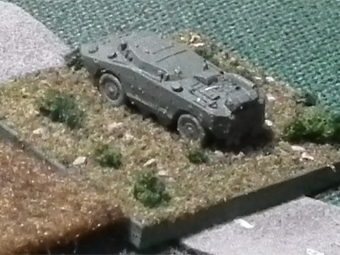
Here's another OT-65; this one is half of my Divisional Recon Battalion's Deep Recon platoon. The Divisional Recon Battalion in its 1980 incarnation consists of the following stands:
1 Battalion HQ stand, in OT-65 (in the late 80s this would be in the Czechoslovakian equivalent of the BMR);The BVP stands are not combat teams, so can't dismount. The deep recon platoon can alternatively be fielded as a single engineer element transported in the division's Mi-4 helicopter stand; but I am not sure what utility this would have in an actual game. The deep recon platoon's main real-life task was to establish the division's route of advance had not been physically compromised due to blown bridges, etc.
1 Engineer stand in OT-62 (whose real-life tasks mostly involved removing road blocks);
2 OT-65 stands for the deep reconnaissance platoon; and
6 BVP stands, split between two recon companies.
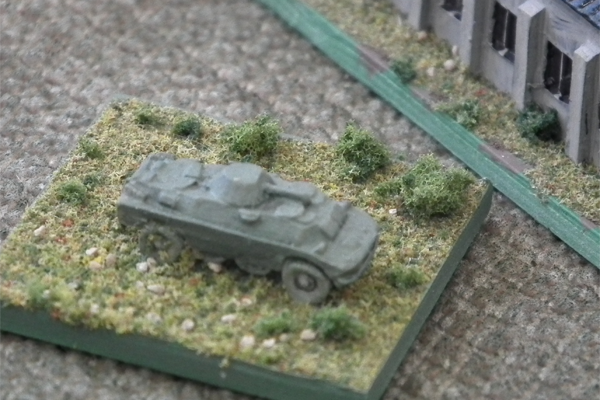
Just for completeness, here is the standard H&R BRDM-2 model. The Czechoslovakians didn't use the standard BRDM-2, so this only gets fielded when I am modelling a force from some other WarPac nation. The model is OK, but the mould is getting somewhat a bit long in the tooth now, leading to a slight loss of crispness; the 14.5 mm HMG is also (naturally) rather over scale, and is not free of the vehicle body, again not expectedly given its scale - but it can be done, because the H&R PSzH APC with the same gun in essentially the same turret comes with a nicely modelled separate turret... Rather weirdly, the rules give a standard BRDM-2 a 2/2 defence factor, but all BRDM-2 derivatives, like the SA-9 for example, or the 9P133 and 9P148 ATGW vehicles, get a 3/2 defence, despite having identical thicknesses of armour...

This is the H&R BDRM-2UM (called a BRDM2u in their catalogue), with a guy holding binoculars added by me. This is a nice clean casting (except for the top box, which is oddly malformed); nobody needs to buy many of these models, so the mould obviously doesn't see too much use. This model only gets used when I am using a non-Czechoslovak force, and then typically only as a forward observer element for towed artillery of some kind (since self-propelled battalions get an IV12 vehicle); in real life this was not a common command vehicle at all; I am not sure exactly what kind of unit would usually use it. The box on the back is a generator to power the extra radios, etc.
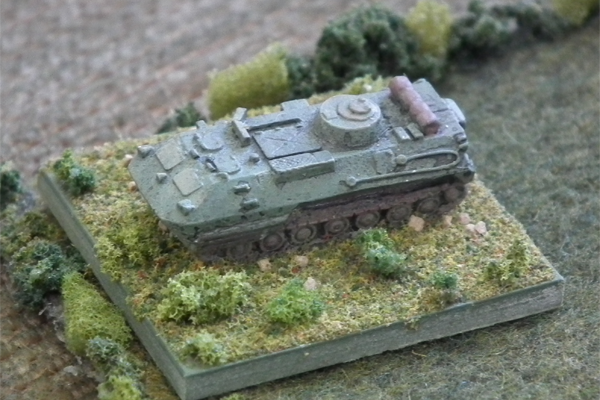
This is an 1V12 vehicle of some description. 1V12 is the designation for an artillery battalion's complete set of fire control vehicles. The battalion commander's observation vehicle is called a 1V15, and the three battery commanders' observation vehicles are designated 1V14. The three battery fire control vehicles, which stay with the batteries, and commanded by each battery's 2iC, are called 1V13, while the battalion 2iC's fire control vehicle is the 1V16. The 1V12 is based on the MT-LBu, which is in turn, essentially an enlarged MT-LB, being both longer (with 7 road wheels a side, not 6) and higher. The turret typically carries no armament, but rather has various observation and range-finding devices. In my Czechoslovakian force, I use 1V12s as forward observer elements for those few battalions that are equipped with 2S1 self-propelled artillery pieces - I haven't been able to find out if DANA-equipped units also used the 1V12 series, so I tend to use OT05s for them. the model, by H&R, is nice and crisp; I should probably have tried to paint the cable on the side something other than the base green, but my eyesight isn't really up to it these days!

Back to my photos top page.